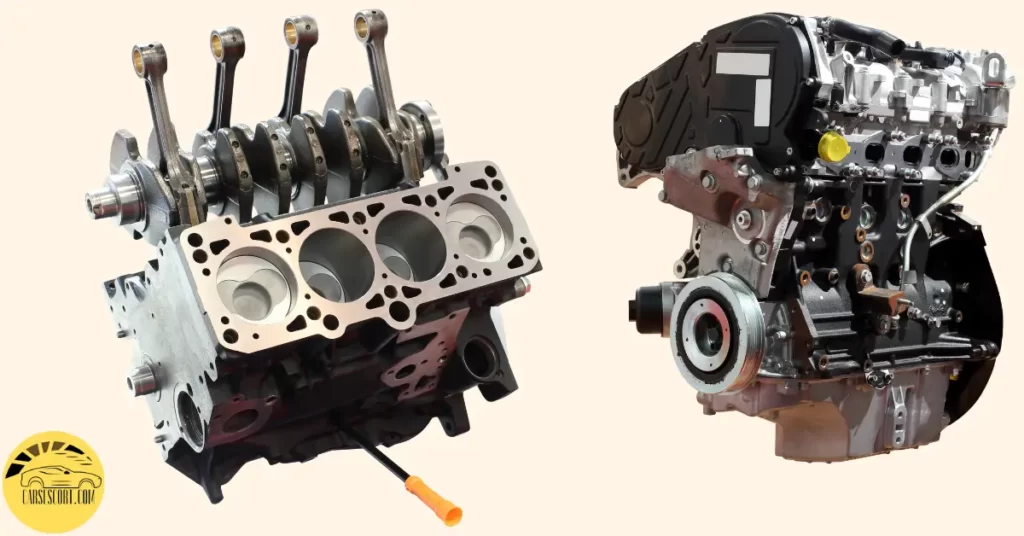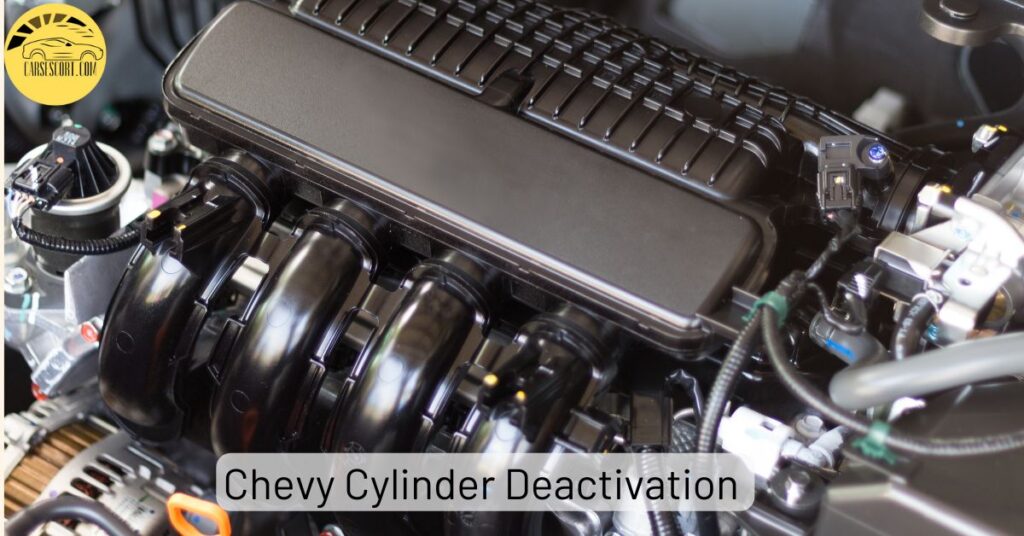Chevy cylinder deactivation, also called active fuel management technology, was introduced in 2005. Chevy trucks and SUVs having Vortec 5.3L V8 LMG engines (Year Models 2007-2014) have AFM cylinder deactivation technology. GM discontinued AFM/DFM in 2021/2022 models.
Chevy Cylinder Deactivation Years
- Chevy Silverado 2007-2104 A 5.3-liter V8 (315 hp, 338 lb-ft)
- Chevrolet Tahoe with 5.3L V-8 L83
- Chevrolet Suburban with 5.3L V-8 L83
Chevy Cylinder Deactivation (Active Fuel Management) is a technology used in certain Chevrolet vehicles to improve fuel efficiency.
It is a system designed to temporarily disable some of the engine’s cylinders under light load conditions, such as highway cruising or coasting, where less power is needed.
By deactivating cylinders, the engine consumes less fuel and reduces emissions.

How Does An Active Fuel Management System Work?
The cylinder deactivation system typically uses a series of electronically controlled solenoids that control the oil pressure and flow to the engine’s hydraulic lifters.
When the system detects the appropriate conditions, it deactivates specific cylinders by preventing the lifters from actuating the valves, effectively stopping the intake and exhaust processes in those cylinders.
The deactivated cylinders continue to move up and down with the engine’s motion, but they do not contribute to power production.
The engine operates more efficiently by deactivating cylinders by reducing pumping losses and friction. This improves fuel economy by allowing the engine to run on fewer cylinders, effectively conserving fuel when the engine’s full power is not required.
When the driver demands more power, the system reactivates the previously deactivated cylinders seamlessly, restoring the engine’s full capacity.
Chevrolet’s AFM system is designed to balance fuel efficiency and performance. It aims to optimize fuel consumption by activating or deactivating cylinders based on driving conditions, engine load, and other factors.
Chevy Cylinder Deactivation Years: The AFM technology has been implemented in various Chevrolet models, including trucks, SUVs, and some passenger cars, to reduce fuel consumption and minimize the environmental impact of vehicle operation.
Chevrolet Cylinder Deactivation System Benefits
1) Increase Fuel Economy
The system reduces fuel consumption by deactivating cylinders under light load conditions, resulting in improved overall fuel efficiency.
2) Reduced Emissions
The Cylinder Deactivation system helps lower emissions by consuming less gas and reducing the number of pollutants released into the environment.
3) Seamless Operation
The system activates or deactivates cylinders seamlessly, ensuring a smooth transition without noticeable changes in vehicle performance or drivability.
4) Enhanced Power When Needed
When the driver demands more power, the deactivated cylinders can be reactivated quickly to provide the engine’s full capacity, ensuring optimal performance during acceleration or higher load situations.
5) Cost Savings
With improved fuel efficiency, the active fuel management technology can save drivers money by reducing the frequency of refueling and lowering overall fuel costs.
6) Environmental Friendliness
By reducing fuel consumption and emissions in chevy truck, the system contributes to a greener and more sustainable driving experience, helping to minimize the impact on the environment.
7) Compatible With Various Driving Conditions
The system is designed to adapt to different driving conditions, allowing for cylinder activation or deactivation based on factors such as speed, load, and throttle input, ensuring optimal efficiency in various situations.
8) Preserved Engine Longevity
By reducing the workload on the engine during light load conditions, the Chevrolet cylinder deactivation system can extend the overall lifespan of the engine components and increase computing power, leading to reduced wear and tear and potentially lower maintenance costs.
Cons of Active Fuel Management
- Excessive Oil Consumption
- Fouled Spark Plugs
- Engine and transmission shudder
- Misfires
- Exhaust drone
- Mechanic Noises
- Feeling the Transition
- Premature wear to the valve train
You May Also Like To Read:
General Motors Active Fuel Management Cylinder Deactivation Technology
The GM Generation III, small-block V8 engines used in the GMT800 trucks were replaced in the GMT900 series with the Generation IV small-block V8 engine family.
These newer engines boasted several enhancements, including increased power and the implementation of Active Fuel Management for the 5.3 L and 6.0 L V8 models.
A high-performance 6.2-liter V8 engine with 403 horsepower (301 kW) and 417 lb-ft (565 N⋅m) of torque was introduced in the 2007 Cadillac Escalade and 2007 GMC Denali line. Subsequently, it became available in the Silverado 1500 starting from the 2009 model year.

Difference Between Dynamic Fuel Management and Active Fuel Management
Dynamic Fuel Management (DFM) and Active Fuel Management (AFM) are fuel-saving technologies that Chevrolet employs in their vehicles. While they serve a similar purpose of optimizing fuel efficiency, there are notable differences between the two systems.
Operation:
- Active Fuel Management (AFM): AFM deactivates specific cylinders under light load conditions. It typically offers V8 mode (all cylinders active) and V4 mode (select cylinders deactivated).
- Dynamic Fuel Management (DFM): DFM takes cylinder deactivation to a more advanced level. Based on real-time demands, it can deactivate any number of cylinders, from one to all eight. DFM offers 17 different cylinder activation patterns for more precise and efficient fuel management.
Precision:
- AFM: AFM uses a fixed pattern of cylinder deactivation, generally activating or deactivating groups of cylinders, such as deactivating 2, 3, 5, and 8.
- DFM: DFM system employs a highly adaptive and dynamic approach. It can individually deactivate or reactivate any cylinder based on the specific demands of the driving conditions. This allows for more precise gas delivery and responsiveness.
Efficiency and Performance:
- AFM: AFM provides noticeable gas efficiency improvements compared to non-cylinder deactivation engines. It offers a balance between fuel economy and performance.
- DFM: Dynamic Fuel Management system takes fuel efficiency to a higher level by providing more control and flexibility. It can tailor cylinder activation patterns to optimize gas consumption based on real-time needs, enhancing efficiency and potentially even better performance.
Vehicle Applications:
- AFM: AFM was introduced by Chevrolet in 2005 and has been utilized in various V8 engine models across Chevrolet’s lineup.
- DFM: DFM represents a more advanced evolution of cylinder deactivation technology and has been implemented in newer Chevrolet models equipped with V8 engines. It offers a higher level of efficiency and adaptability compared to AFM.
What Chevy Engines Have Cylinder Deactivation?
- 5.3L V-8 Vortec 5300
- 3.9L V-6 LZ8
- 5.3L V-8 LS4
- 6.2L V-8 L99
- 4.3L V-6 LV3
- 5.3L V-8 L83
- 6.2L V-8 L86
- 3.6L V-6 LGX Naturally Aspirated
- 3.0L V-6 LGW Twin-Turbo
- 4.2L V-8 LTA Twin-Turbo
FAQ
What Chevy Trucks Have Cylinder Deactivation?
Chevy trucks having Vortec 5.3L V8 LMG engines have cylinder deactivation.
What Year Did Chevy Start Using Cylinder Deactivation?
Chevrolet introduced their Cylinder Deactivation system, also known as Active Fuel Management (AFM), in 2005. The AFM technology was first implemented in select V8 engines used in Chevrolet vehicles.
This innovative system allowed specific cylinders to be deactivated under light load conditions to improve gas efficiency and reduce emissions.
Over the years, Chevrolet has continued to refine and expand the use of Cylinder Deactivation in their engine lineup, offering this technology in various models to enhance the overall fuel economy of their vehicles.
Does Chevy still do cylinder deactivation?
No, Chevy does not currently offer cylinder deactivation in its vehicles. Chevy has been gradually phasing out cylinder deactivation in its newer models.
Do all 5.3 have cylinder deactivation?
Cylinder deactivation technology is typically employed in specific engines to improve fuel efficiency. While some versions of the 5.3-liter engine may include cylinder deactivation, it is not a universal feature across all engines of that specific displacement. The presence of cylinder deactivation depends on the specific model, make, and year of the engine in question.
Reference:
Conclusion
Chevy’s cylinder deactivation technology has made significant strides in improving fuel efficiency and reducing the environmental footprint of their vehicles. Introduced in 2005, AFM was integrated into Vortec 5.3L V8 LMG engines in Chevy trucks and SUVs from 2007 to 2014, showcasing its effectiveness in those models.
However, it is important to note that GM has chosen to discontinue AFM/DFM in their 2021 and 2022 models. Despite this, the implementation of AFM in various Chevrolet models, including trucks, SUVs, and select passenger cars, has undoubtedly played a role in achieving lower fuel consumption and promoting eco-friendly vehicle operation.
Affiliate Disclosure: Cars Escort is a participant in the Amazon Services LLC Associates Program. As an Amazon Associate, we earn from qualifying purchases made through affiliate links on our site. Read Our Disclaimer .

